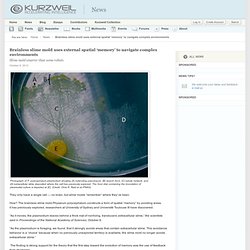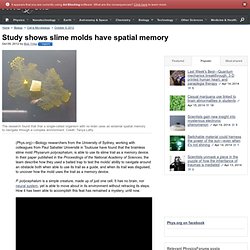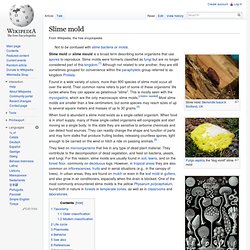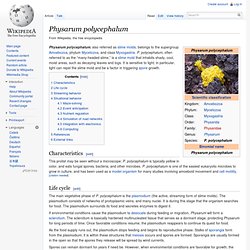

BBC Nature - Brainless slime mould has an external memory. 9 October 2012Last updated at 07:45 By Ella Davies Reporter, BBC Nature The "remarkably intelligent" slime mould Slime moulds use a form of spatial "memory" to navigate, despite not having a brain, a study has found.

Scientists in Australia studied the organisms in an experiment normally used to test robots. They found that the slime mould could navigate around a U-shaped maze to a food source, using their slimy deposits. Researchers compare its path-finding method to Hansel and Gretel's breadcrumb trail. Their full findings are published in the journal Proceedings of the National Academy of Sciences. "A slime mould is not a fungus or mould, but is in fact a protist, which is really the odds and ends of the natural world that don't fit in with the rest of our taxonomic grouping system," said PhD student Christopher Reid who led the study.
Brainless slime mold uses external spatial ‘memory’ to navigate complex environments. Photograph of P. polycephalum plasmodium showing (A) extending pseudopod, (B) search front, (C) tubule network, and (D) extracellular slime deposited where the cell has previously explored.

The food disk containing the inoculation of plasmodial culture is depicted at (E). (Credit: Chris R. Reid et al. /PNAS) Slime Has Memory but No Brain. In experiments with the slime mold , scientists at the University of Sydney noticed that the life-form avoided retracing its own paths.

They began to suspect that the slime was using "externalized spatial memory" to navigate. "The slime mold leaves behind a trail of slime everywhere it goes, which it can then detect later to recognize areas it has already been," said biologist Chris Reid . To test this theory, researchers placed in a U-shaped trap. On an untreated surface, 96 percent of the specimens were able to steer through the trap to find a sugar solution before the time limit of 120 hours. But when the trap had already been coated with slime, so that the specimens could not distinguish their own trails, only a third of the organisms reached the goal before the time limit and spent ten times longer returning to areas they had already been.
The team's current research also suggests that can recognize and react to the trails left by other species of slime mold. Video: Slime Mold's Powers of Recall Hint at Origin of Memory. When next you encounter a slime mold, take a moment to consider the notion that its glistening trail contains the origins of memory itself.

It may seem a stretch to lay higher life’s most essential mental faculty at the feet, figuratively speaking, of an amoeboid that’s not even an animal. Yet though they have but a single cell, slime molds remember where they’ve been. “It doesn’t have a brain. It doesn’t even have a neuron. It has to do everything with just one cell,” said Audrey Dussutour, a collective behavior specialist at France’s National Center for Scientific Research.
Observation Deck: What 'Smart' Slime Molds Tell Us About Alien Intelligence. Study shows slime molds have spatial memory. (Phys.org)—Biology researchers from the University of Sydney, working with colleagues from Paul Sabatier Université in Toulouse have found that the brainless slime mold Physarum polycephalum, is able to use its slime trail as a memory device.

In their paper published in the Proceedings of the National Academy of Sciences, the team describe how they used a baited trap to test the molds' ability to navigate around an obstacle both when able to use its trail as a guide, and when its trail was disguised, to uncover how the mold uses the trail as a memory device. P. polycephalum is a simple creature, made up of just one cell. It has no brain, nor neural system, yet is able to move about in its environment without retracing its steps. How it has been able to accomplish this feat has remained a mystery, until now. Introduction to the "Slime Molds" Long classified together in the Myxomycophyta as part of the Fungi, slime "molds" are now known to be quite unrelated to the fungi.

There are three main groups of slime molds, which do not form a clade. Plasmodial slime molds, like Physarum shown here, are basically enormous single cells with thousands of nuclei. They are formed when individual flagellated cells swarm together and fuse. The result is one large bag of cytoplasm with many diploid nuclei. These "giant cells" have been extremely useful in studies of cytoplasmic streaming (the movement of cell contents) because it is possible to see this happening even under relatively low magnification. A second group, the cellular slime molds, spend most of their lives as separate single-celled amoeboid protists, but upon the release of a chemical signal, the individual cells aggregate into a great swarm. Slime mold. Mycetozoa from Ernst Haeckel's 1904 Kunstformen der Natur (Artforms of Nature) Found in a wide variety of colors, more than 900 species of slime mold occur all over the world.

Their common name refers to part of some of these organisms' life cycles where they can appear as gelatinous "slime". This is mostly seen with the myxogastria, which are the only macroscopic slime molds. [citation needed] Most slime molds are smaller than a few centimeters, but some species may reach sizes of up to several square meters and masses of up to 30 grams.[2] When food is abundant a slime mold exists as a single-celled organism.
They feed on microorganisms that live in any type of dead plant material. Taxonomy[edit] Older classification[edit] Physarum polycephalum. Physarum polycephalum, also referred as slime molds, belongs to the supergroup Amoebozoa, phylum Mycetozoa, and class Myxogastria.

P. polycephalum, often referred to as the “many-headed slime,” is a slime mold that inhabits shady, cool, moist areas, such as decaying leaves and logs. It is sensitive to light; in particular, light can repel the slime mold and be a factor in triggering spore growth. Characteristics[edit] This protist may be seen without a microscope; P. polycephalum is typically yellow in color, and eats fungal spores, bacteria, and other microbes. P. polycephalum is one of the easiest eukaryotic microbes to grow in culture, and has been used as a model organism for many studies involving amoeboid movement and cell motility. Life cycle[edit] Slime mold uses an externalized spatial “memory” to navigate in complex environments. Slimed! Scientists Discover that Evolution of Memory Started by Feedback from Chemicals. “As it moves, the plasmodium leaves behind a thick mat of nonliving, translucent, extracellular slime,” the scientists said in Proceedings of the National Academy of Sciences, October 8.

“As the plasmodium is foraging, we found. that it strongly avoids areas that contain extracellular slime. This avoidance behavior is a ‘choice’ because when no previously unexplored territory is available, the slime mold no longer avoids extracellular slime.” “We have shown for the first time that a single-celled organism with no brain uses an external spatial memory to navigate through a complex environment,” said Christopher Reid from the University’s School of Biological Sciences. "Our discovery is evidence of how the memory of multi-cellular organisms may have evolved — by using external chemical trails in the environment before the development of internal memory systems,” Reid added.